

In Construction
Battle at Mevania (308 BC)
The Umbrians made their first significant entry into recorded history after the end of the Etruscan War of 311/10-8. According to Livy:
-
“The tranquillity that now obtained in Etruria was disturbed by a sudden revolt of the Umbrians, who had escaped all the distress of war, except that an army had passed through their territory”, (‘Roman History’, 9: 41: 8).
This seems to ignore Livy’s record of a rout of the Umbrians in 309 BC, but to tie in with Diodorus’ account if, as suggested above, it signified that the Romans had crossed Umbrian territory in 308 BC in order to attack the strongholds in the territory of Volsinii.
Livy then gave the only surviving account of the Umbrians’ collective response to this presumed provocation:
-
“Calling up all their fighting men, and inducing great part of the Etruscans to rebel, they mustered so large an army, that they boasted ... that they would leave Decius behind them in Etruria and march off to the assault of Rome. When this purpose of theirs was reported to the consul Decius, he hastened by forced marches from Etruria towards [Rome], and encamped in the ager Pupiniensis, eagerly waiting for word of their approach. At Rome no one made light of an Umbrian invasion: their very threats had excited fear in those who had learnt from the Gallic disaster [of ca. 390 BC] how unsafe was the city they that they inhabited. Accordingly, envoys were dispatched to carry word to Fabius the consul, that, if there were any slackening in the Samnite war, he should lead his army into Umbria with all speed. The consul obeyed the order and advanced by long marches to Mevania, where the forces of the Umbrians at that time lay”, (‘Roman History’, 9: 41: 9-13).
According to Stephen Oakley (referenced below, 2005, at pp. 541-2), the territory of Pupinia to which Decius retreated was north of the river Anio/Aniene, northeast of Rome.
Threat from an Umbrian League ?
According to Simone Sisani (referenced below, 2002, p. 493):
-
“The words ‘concitata omni iuventute sua’ [calling up all their men of fighting age, which Livy] used to describe the calling up of the armies of the Umbrians, does not leave room for doubt: we must be dealing with the dilectus [military recruitment levy] of the entire nomen umbro [tribes of the Umbrian ‘name] working within a league, as is also suggested by the use of the simple ethnic [‘Umbrian’] to describe the force opposing Fabius ...” (my translation).
However, as noted above, Livy sometimes referred (for example) to ‘the Etruscans’ when he probably meant only those Etruscan city states that were engaged in hostilities against Rome at a particular point in time. Thus, pace Sisani, we cannot assume from the passage above that the “entire nomen umbro” sent men to Mevania. After all, at least two Umbrian tribes, the ‘Camertes Umbros’ (see above) and the Ocriculani (see below), are unlikely to have sent men to fight the Romans at this time. Having said that, if Livy’s claim that the army mustered at Mevania was a particularly large one is correct, then it would follow that it contained men from a large number of Umbrian tribes that were, at least on this occasion, “working within a league”.
That brings us to the key point: how large was the Umbrian army mustered at Mevania ? Livy made two claims in this respect:
-
✴The first related to Decius’ response:
-
“[The Umbrians] mustered so large an army, that they boasted ... that they would leave Decius behind them in Etruria and march off to the assault of Rome”
-
✴ The second related to the reaction at Rome, where:
-
“... no one made light of an Umbrian invasion: their very threats had excited fear in those who had learnt from the Gallic disaster how unsafe was the city that they inhabited.”
-
This seems unlikely, particularly since Livy never claimed that the army of ‘the Etruscans’ had managed to excite such fear in Roman hearts in 310 BC, when it had actually crossed the Ciminian forest had laid siege to Sutrium, one of the two ‘gates and barriers’ protecting Rome (see above).
In other words, it seems likely that Livy exaggerated the strength of the Umbrian army mustered at Mevania (possibly for reasons discussed below). If so, then all we can take from the passage above is that some Umbrian tribes apparently formed an alliance and that each of them sent all their men of fighting age to the muster at Mevania,
If we put this passage of Livy to one side, it has to be said that the evidence fo the existence of an Umbrian league is relatively weak. For example, it is surely significant that, while the ‘fasti Triumphales’ recorded two Roman triumphs that were won in Umbrian territory (over ‘the Nequinates (at modern Narni) in 299 BC and over ‘the Sassinates’ (at modern Sarsina) in 266 BC), they contain no record of a Roman triumph over ‘the Umbrians’ collectively (while several triumphs were awarded for victories over, for example, ‘the Etruscans’ and the ‘Samnites’). Stephen Oakley (referenced below, 2007, at p. 28) reasonably pointed out that:
-
“Our knowledge of how the non-Roman and non-Greek peoples of Italy governed themselves in the late 4th and early 3rd centuries BC is so poor that it is perhaps rash to generalise from silence.”
Nevertheless, he suggested that a reasonable deduction from all of Livy’s references to the Umbrians in the period 311 - 266 BC is that:
-
“... the Umbrian peoples were not united by any strong, central government, and that that they did did not present a strong united force to counter the menace of Rome: witness the manner in which Rome had separate dealings with Camerinum [above], Ocriculum [below], Nequinum and Sassina.”
William Harris (referenced below, at p. 101) was less guarded:
-
“Although the Umbrian peoples naturally allied themselves for military purposes [in the pre-Roman period, as they had, for example in 308 BC], there is no evidence worthy of the name that there was an Umbrian League of any importance [that was placed politically] above the individual states.”
Federal Sanctuary at Villa Fidelia, below Mevania ?
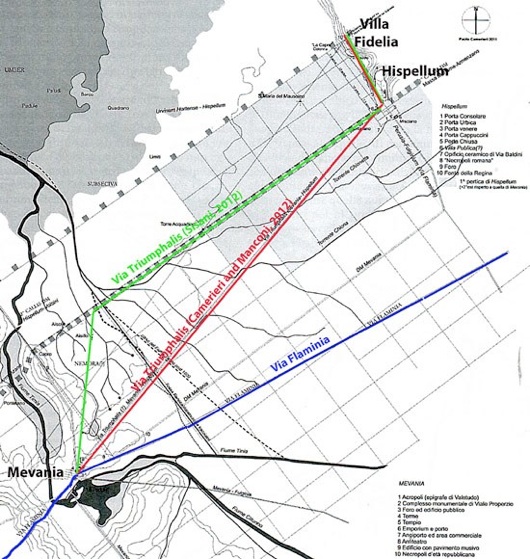
Possible route of the via triumphalis mentioned in CIL XI 5041
Adapted from Camerieri and Manconi (referenced below, 2012, Figure 17)
(The route in green is as proposed by Simone Sisani (referenced below, 2012, Figure 13)
So far, the arguments for and against the existence of an Umbrian League in the pre-Roman period have been discussed largely on the basis of the surviving literary sources. However, a number of scholars who have argued in favour of this hypothesis have also pointed to archeological and epigraphic evidence that, in their view, suggests the presence of a pre-Roman federal sanctuary o at what is now the site of Villa Fidelia, below the walls of nearby Hispellum (Spello). On this model, Mevania was the capital of the putative Umbrian League, a situation mirrored, for example:
-
✴ at Volsinii, the site of the putative Etruscan federal sanctuary at the fanum Voltumnae; and
-
✴at Pietrabbondante/ Aquilonia, the putative site of the federal sanctuary of the Samnites and, in particular, the site of the muster of a Samnite army in 293 BC, described in Livy (‘History of Rome’, 10: 38-41)
Thus:
-
✴In relation to Volsinii, Simone Sisani (referenced below, 2002, at p. 499) suggested, on the basis of the small inscribed votive altar found at Villa Fidelia (discussed below), that the sanctuary here had probably been dedicated to ‘iuvipatre’ in the pre-Roman period, and that this deity represented:
-
“... a perfect parallel to Tinia, venerated at the [pan-Etruscan sanctuary of] fanum Voltumnae at Volsinii ... the probable model for the Umbrian sanctuary [at Villa Fidelia]” (my translation).
-
✴In relation to Pietrabbondante/ Aquilonia:
-
•Simone Sisani (referenced below, 2002, p. 493):
-
“It is absolutely probable that the concentration of the Umbrian army [at Mevania in 308 BC] took place near the capital of the federation [i.e. Mevania], as is suggested by analogous examples, such as that of the Samnite dilectus of 293 BC at Aquilonia” (my translation).
-
•Filippo Coarelli (referenced below, 2001, at p. 48):
-
“We know from Livy that, at least in 308 BC, the place where the Umbrian army mobilised [to plan an attack on Rome] was at Mevania. There must have been a nearby sanctuary of the Umbrian nomen, analogous to those we know about belonging to other pre-urban and proto-urban peoples of ancient Italy. One thinks here of the sanctuary of Pietrabbondante, for the Pentrian Samnites” (my translation).
-
•Simone Sisani (referenced below, 2012, at p. 421):
-
“... the choice of [Mevania] for the mustering of the Umbrian army [in 308 BC] cannot have been accidental: as in the case of the tumultuous levy organised by the Samnites at Aquilonia in 293 BC, the choice must have fallen on the political and religious centre of the league, which could offer both the facilities (material and ritual) adequate for a concentration of such proportions and the necessary co-ordination of the actions of the separate contingents” (my translation).
Enrico Zuddas and Maria Carla Spadoni (referenced below, at pp. 57-8) made a separate and complementary point:
-
“If Appian (‘Civil Wars’, 4:3] was correct in stating that the cities chosen for [the foundation of veteran colonies in 43 BC] were among the most prosperous and civilised of Italy, then [Hispellum seems to have been an exception]. ... The choice of [Hispellum] for the foundation of a colony seems therefore to have been dictated by other considerations: certainly by its centrality in the [Valle Umbra] but, above all, by the presence in its immediate vicinity of the federal sanctuary of Umbria, on the site of the present Villa Fidelia” (my translation).
Early Archeological Evidence
here is very little direct evidence for cult practices at Villa Fidelia before the Roman conquest of Umbria:
-
✴Manconi, Camerieri and Cruciani (referenced below, p. 391, note 54) recorded that:
-
“... a votive bronze in the form of a hand, typical for Umbrian sanctuaries of 5th and 4th centuries BC, [was] found in the deeper strata [of emergency excavations carried out on the site in 1990]...” ( my translation).
-
As far as I am aware, this object is otherwise unpublished and (if it survives at all) is not available to the public.
-
✴The excavations of 1990 also uncovered the small sandstone altar mentioned above, which has an Umbrian inscription on one of its upper edges. This can be transcribed as:
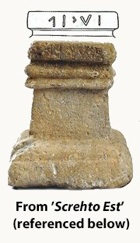
-
iuvip(atre)
-
There is some uncertainty about the date of the inscription:
-
•Alberto Calderini (in L. Agostiniani, referenced below, entry 27) dated the alphabet used in it to the period between the mid 3rd century and the early 2nd century BC, although he conceded that there was some uncertainty.
-
•Simone Sisani (referenced below, 2012, at p. 424 and note 86) regarded this as too late, and alternatively dated it to the 4th or 3rd century BC.
-
Dorica Manconi (also in L. Agostiniani, referenced below, entry 27) asserted that the altar had almost certainly supported a small bronze votive offering to the god, which suggests the presence of a nearby temple of this dedication.
There is more evidence of cult activity here later in the Republican period, albeit that this does not suggest the presence of a major sanctuary:
-
✴Paolo Camerieri and Dorica Manconi (referenced below, 2012, at Figure 1 and pp. 67-8) discovered the remains of a temple during the recent restoration of the nunnery of the Suore Francescane Piccolo San Damiano . This temple was later extended and incorporated into the Augustan sanctuary as the Temple of Venusdiscussed below. They suggested that its original construction:
-
“... might be ascribed to roughly the period ... of the original urbanisation [of Hispellum] in the late 3rd or 2nd century BC” (my translation).
-
✴Manconi, Camerieri and Cruciani (referenced below, at p. 389) recorded that the excavations of 1990 also:
-
“... brought to light architectural terracottas of the 2nd-1st centuries BC, as well as other finds that support the hypothesis of the presence [here] of an ... Italic sanctuary” (my translation).
-
Unfortunately, these finds were never published, and the information above is all we have (as far as I know).
The case for the existence of a pre-Roman federal sanctuary here therefore relies on circumstantial evidence from later periods,which I discuss in my page on ‘Bevagna; History: Villa Fidelia before 41 BC’. The main elements of the case relate to:
-
✴the Augustan sanctuary here;
-
✴the epic evidence for the fact that it was linked to Mevania by an epigraphically-attested via triumphalis that might reflect a more ancient history; and
-
✴the evidence of the so-called Rescript of Constantine.
Augustan Sanctuary
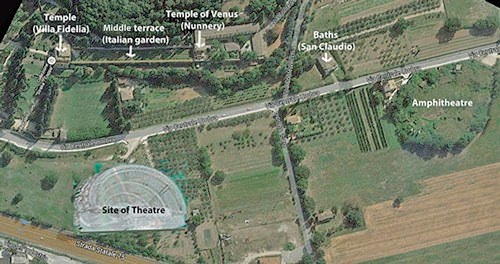
Aerial view of the site of the sanctuary as monumentalised in the Augustan period
The likely plan of the now-demolished theatre is overlaid at the lower left
As noted above, whatever remained of a sanctuary here the sanctuary was monumentalised soon after the foundation of the colony of Hispellum in ca, 40 BC. From that point, it comprised:
-
✴a system of three terraces, with the middle one now forming the Italian garden of Villa Fidelia;
-
✴two main temples, one at each end of this middle terrace:
-
•one temple almost certainly stood at the west end of the terrace, on the site of the present Villa Fidelia (although its existence is largely inferred from the symmetrical arrangement of the site); and
-
•the second temple (securely identified and known to have been dedicated to Venus after colonisation) stood at the east end, on a site that now belongs to the nunnery of the Suore Francescane Piccolo San Damiano;
-
✴a remarkably large theatre that was symmetrically located in relation to these two main temples;
-
✴a thermal complex near the site of the present church of San Claudio; and
-
✴an amphitheatre, slightly further to the east.
As discussed in my page on ‘Spello: History: Sanctuary at Villa Fidelia after Colonisation’, the Temple of Venus probably dated to the triumviral period, the rest of the sanctuary was probably built in ca. 27 BC. For our present purposes, the most important part of the complex was the theatre: Filippo Coarelli (referenced below, at p. 47) pointed out that its dimensions, which were:
-
“... excessive for a small city like Hispellum, can be perfectly explained if it was intended for use by the whole nomen Umbro. Although we are dealing with an Augustan complex, it is important to take account of this factor in order to avoid much useless discussion” (my translation).
In other words, Coarelli suggested that the dimensions of the theatre indicate pan-municpal use in the Augustan period, and that this reflected the Augustan monumentalisation of the original federal sanctuary of the Umbrian League.
Via Triumphalis
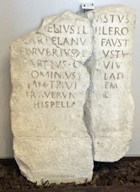
-
viam triumphalem / straverunt lapide / Hispellate
-
The triumphal way was paved with stone from Hispellum
It seems likely that the missing upper part of the inscription recorded:
-
✴the novemvirii Valetudinis, the magistracy to which all six men almost certainly belonged, which had presumably financed the paving of the road; and
-
✴the names of the three other members of this magistracy at the time of the inscription.
Simone Sisani (referenced below, 2012 at p. 416) dated the inscription on paleographic grounds to the start of the reign of Augustus (i.e. to ca. 27 BC), although the Eagle database (see the CIL link above) gives a later date, the early 1st century AD. Simone Sisani deduced (at p. 418) that:
-
“... the [likely route of the] via triumphalis does not seem to bear any relationship to the surrounding urban centres. Moreover, its name refers explicitly to a road with purely religious associations and as such it probably connected Mevania, not to another city, but to a sanctuary” (my translation).
The implication is that this road, which was paved (or re-paved) in the early imperial period, had probably originally connected Mevania to the the sanctuary of the Umbrian League at Villa Fidelia (see the map at the top of this section).
Rescript of Constantine
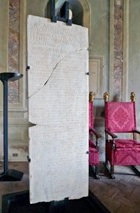
Conclusions
Given the complicated nature of the evidence, it is hard to improve on the following summary by John Scheid (referenced below, 2006, at p. 82):
-
“... according to the archaeologists, the large [triumviral/ Augustan] sanctuary at [Villa Fidelia] ... could have succeeded an important supra-regional sanctuary of the Umbrians. [As in other cases], the reason for the foundation of a colony [at the relatively small urban centre of Hispellum in the triumviral period might thus have been] the presence of [this putative] renowned Italic supra-regional cult site. Unfortunately, all we know for certain at the moment is that this sanctuary had a supra-regional role in the [4th century AD, as evidenced by the Rescript of Constantine]. ... The place was clearly very important:
-
✴... Octavian ... had confiscated the famous [and probably ancient] sanctuary at the source of the Clitumnus from Spoletium, which had owned it since the deduction of the colony [there in 241 BC] and given it to the Hispellates.
-
✴Perhaps he had similarly confiscated [an ancient and] supra-regional sanctuary at Villa Fidelia [from Mevania] to make a [new] colony and an urban centre [at Hispellum]” (my translation, with changed word-order in the first bullet point that preserves the original sense).
Fabius’ Victory at Mevania
According to Livy, Fabius:
-
“... obeyed the order [to leave Samnium] and advanced by long marches to Mevania, where the forces of the Umbrians at that time lay. The sudden arrival of the consul, whom they had believed to have his hands full with another war in Samnium, a long way from Umbria, so dismayed the Umbrians that:
-
✴some were for falling back on their fortified cities; and
-
✴others for giving up the war.
-
But one plaga (district), which they themselves call Materina, not only kept the rest to their arms, but also brought them to an immediate engagement. Fabius was entrenching his camp when they attacked him. As soon as he saw them rushing madly upon his ramparts, he recalled the soldiers from their work and drew them up, as time and the nature of the ground permitted, and encouraging them with a true relation of the honours they had won, some in Etruria and some in Samnium, bade them:
-
✴to end this trivial sequel to the Etruscan war; and
-
✴to take revenge upon the foe for his impious threat that he would assault the city of Rome.
-
These words were received by the soldiers with such alacrity that the speech of the general was interrupted by a spontaneous cheer. Then, before the command could be given, they hurled themselves ... with the wildest abandon against the enemy. They ... began with tearing the standards out of the bearers' hands, and then fell to dragging the bearers themselves before the consul ... Wherever they met with resistance, they attacked with shields rather than with swords, swinging them from the shoulder and knocking down their enemies with the bosses. The slain were outnumbered by the prisoners, and one cry was heard all along the [Umbrian] battle line: that they should lay down their arms. And so, while the battle was still going on, the surrender was made by the men who had first advocated war [who presumably came from Materina]. On the next and on succeeding days, the other peoples of Umbria also capitulated. The men of Ocriculum [Otricoli] were received into friendship by sponsio [see below]”, (‘Roman History’, 9: 41: 13-20).
Thus, according to Livy, Fabius secured this victory principally by the strength of his magnificent oratory. A clue to his source for this information (which allowed him to put appropriate words into Fabius’ mouth) might lie in the reference to the otherwise-unknown Materina: Gary Forsythe (referenced below, at p. 295) pointed out that this was one of :
-
“... several otherwise-unattested toponyms [in Livy’s narrative] that are associated with Roman military campaigns.”
He suggested that Livy had found at least some of these toponyms in family records. In particular:
-
“It is noteworthy that two of the eight [such toponyms that he had listed] are associated with two military campaigns of Q. Fabius Maximus Rullianus, and that Q. Fabius Pictor, Rome’s first native historian, was a collateral kinsman of this man.”
I think that Livy exaggerated the pan-Umbrian nature of the threat in order:
-
✴to account for the fact that (presumably according to his source(s) - see below) Decius fell back on the ager Pupiniens, and
-
✴to magnify the importance of the victory of Fabius (see below), whom Stephen Oakley (referenced below, 2007, at p. 19), for example, described as “Livy’s hero”.
Treaty with the Ocriculum (308 BC)
Livy added a postscript to the passage above:
-
“Ocriculani sponsione in amicatiam accepti (the men of Ocriculum [modern Otricoli] were received into friendship by sponsio)”, (‘Roman History’, 9: 41: 20).
I have taken this translation into English from Kathryn Lomas (referenced below, at p46), who noted that:
-
“The interesting thing about the Ocriculani is that they joined the Roman power bloc by sponsio, a formal agreement [that was] usually negotiated in the field by a general and then ratified by the Senate, rather than by a treaty.”
Other important facts about Ocriculum relate to its location: it was on the Tiber, which probably marked the southern boundary between Umbrian and Faliscan territory, and was thus the nearest Umbrian centre to Rome. Furthermore, it overlooked the confluence of the Tiber and the Nera. William Harris (referenced below, at p. 59) expressed the view that its sponsio with Rome:
-
“... was clearly part of [a] ... policy of securing a route up the Tiber and Nera valleys, ... the next stage of which was the colonisation of [Nequinum/ Narnia, sited in the Nera valley at modern Narni] in 299 BC [see below].
Given the placing of this ‘postscript’, it is usually assumed that Ocriculum received its sponsio immediately after the battle at Mevania in 308 BC. However, Livy does not explicitly say so. William Harris pointed out (at p. 57) that it must have existed by 299 BC, since the new colony of Narnia”
-
“... would otherwise have been separated from Rome by hostile territory.”
Hostilities intensified during the Third Samnite War (298-90 BC) when the Etruscans were allied with the Samnites:
-
✴after the decisive Battle of Sentinum (294 BC), a triumph awarded over the Samnites, Etruscans and Gauls in 295 BC to Fabius Maximus Rullianus (his consular colleague having been killed in the battle); and
-
✴two triumphs were celebrated on successive days in 293 BC, by:
-
✴Lucius Postumius Megellus, over the Samnites and Etruscans; and
-
✴Marcus Atilius Regulus, over the Volsones [probably the Volsinians] and Samnites.
It was at this point that the Faliscans joined the revolt:Livy reported that, later in 293 BC:
-
✴“... the Faliscians ... , who had for many years lived in friendship with Rome, had united their arms with those of the Etrurians. ... [As a result,] war was declared against the Faliscians ...”, (‘Roman History’, 10: 45: 6-11).
-
✴The consul Spurius Carvilius Maximus ravaged their territory, after which they requested and were granted peace in return for a significant fine (‘Roman History’, 10: 46: 10-12).
It seems that tensions eased after the end of the Third Samnite War in 290 BC. but that hostilities intensified in ca. 280 BC:
-
✴Book 13 of the epitome of Livy, which largely deals with the Pyrrhic War (280-75 BC):
-
“... also contains an account of the successful wars against the Lucanians, Bruttians, Samnites, and Etruscans”, (‘Periochae’, 13).
-
✴The ‘Fasti Triumphales’ record triumphs awarded to:
-
✴Quintus Marcius Philippus, over the Etruscans in 281 BC; and
-
✴Titus Coruncanius, over the Vulsinienses and Vulcientes (i.e. over Volsinii and Vulci) in 280 BC.
Cassius Dio recorded that:
-
“The [people of Caere], when they learned that the Romans were disposed to make war on them, despatched envoys to Rome before any vote was taken and obtained peace upon surrendering half of their territory” (‘Roman History’, 10: fragment 33).
Scholars are divided on the likely date of these events at Caere. For example:
-
✴William Harris (referenced below, p. 83 and note 3) dated them to 274 or 273 BC, after the end of the Pyrrhic War (see ); while
-
✴Saskia Roselaar (referenced below, at p. 42) asserted that:
-
“...the [Romans’] last war with Etruria ended in 281 BC. It is usually assumed that, on this occasion, Caere, Vulci, Volsinii and Tarquinii lost part of their land.”
In dealing with these land confiscations below, I assume that they took place:
-
✴at Vulci (and, possibly, Volsinii) after the triumph of 279 BC; and
-
✴at Caere and Tarquinii in ca. 280 BC.
Read more:
P. Camerieri and D. Manconi , “Il ‘Sacello’ di Venere a Spello: dalla Romanizzazione alla Reorganizzazione del Territorio: Spunti di Ricerca ", Rivista di Antichità, 21 (2012) 63-80
S. Sisani, “I Rapporti tra Mevania e Hispellum nel Quadro del Paesaggio Sacro della Valle Umbra”,, in
G. Della Fina (Ed.), “Il Fanum Voltumnae e i Santuari Comunitari dell’ Italia Antica”, (2012) Orvieto (pp. 409-64)
L. Agostiniani et al. (Eds), “Screhto Est: Lingua e Scrittura degli Antichi Umbri”, (2011) Città di Castello
E. Zuddas and M. C. Spadoni, “La Lemonia nella Valle Umbra”, in
M. Silvestrini (Ed.), “Le Tribù Romane: Atti della XVIe Rencontre sur l’ Épigraphie (Bari 8-10 ottobre 2009”, (2010) Bari, at pp. 57-64
S. Oakley, “A Commentary on Livy, Books VI-X:Volume III: Book X”, 2007 (Oxford)
J. Scheid, “Rome et les Grands Lieux de Culte d’ Italie”, in:
A. Vigourt et al. (Eds), “Pouvoir et Religion dans le Monde Romain: en Hommage à Jean-Pierre Martin”, (2006) Paris, pp. 75-88
G. Forsythe, “A Critical History of Early Rome: From Prehistory to the First Punic War”, (2005) Berkeley Ca.
S. Oakley, “A Commentary on Livy, Books VI-X:Volume III: Book IX”, 2005 (Oxford)
S. Sisani, “Lucius Falius Tinia: Primo Quattuorviro del Municipio di Hispellum”, Athenaeum, 90.2 (2002) 483-505
F. Coarelli, "Il Rescritto di Spello e il Santuario ‘Etnico’ degli Umbri”, in:
“Umbria Cristiana: dalla Diffusione del Culto al Culto dei Santi,” Atti del XV Congresso Internazionale di Studi sull’ Alto Medioevo, (2001) Spoleto, pp. 39-52
K. Lomas, “Roman Italy, 338 BC - 200 AD: A Sourcebook”, (1996, reprinted 2003) London
D. Manconi, P. Camerieri and V. Cruciani, “Hispellum: Pianificazione Urbana e Territoriale”, in:
G. Bonamente and F. Coarelli (Eds),“Assisi e gli Umbri nell' Antichità” Assisi (1996) pp. 375-423; the section on the sanctuary at Villa Fideliais at pp. 381-92
W. Harris, “Rome in Etruria and Umbria”, (1971) Oxford
Return to Site Map: Romans

